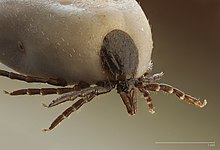Gnathosoma


The gnathosoma (from the Greek. Gnathos = "jaw, jaw" and soma = "body") or capitulum is significantly remote from the rest of the body body portion of the mites , which comprises the mouth area and the associated limbs and the rest of the body, the Idiosoma , is separated. With a large number of mites, it can be withdrawn into the idiosoma, more precisely into the rear part of the opisthosoma .
construction
The gnathosoma comprises the prostomium or acron as well as the first two trunk segments with the chelicerae and the coxae of the pedipalps that have grown together to form a trough in the middle (median) with their wide coxal shutters . With derived forms ( holacarina ), the latter together with a sclerite of the prosomal back (tectum or rostrum), with which they are laterally fused, form a closed oral vestibule.
Systematics
The Gnathosoma is a derived structure that is only developed in the mites within the jaw-claw carriers (Chelicerata). It thus represents an autapomorphy of this group. Even with the most original mites, the notostigmata , the coxal arteries of the pedipalps have grown together as a further autapomorphy of the mites to form a trough-shaped oral vestibule, while the formation of a tube for the entire oral vestibule together with the tectum only occurs in the Holacarina takes place.
supporting documents
- ↑ Gnathosoma. In: Herder-Lexikon der Biologie. Spektrum Akademischer Verlag, Heidelberg 2003, ISBN 3-8274-0354-5 .
- ↑ a b c Willi Hennig : Invertebrates II. 5th edition. edited by Wolfgang Hennig and Gerhard Mickoleit. Gustav Fischer Verlag Jena 1994, ISBN 3-334-60936-7 , p. 74.
- ↑ a b Peter Weygoldt: Chelicerata, arachnids. In: W. Westheide, R. Rieger (Ed.): Special Zoology. Part 1: Protozoa and invertebrates. Gustav Fischer, Stuttgart / Jena 1997, ISBN 3-8274-1482-2 , p. 490.